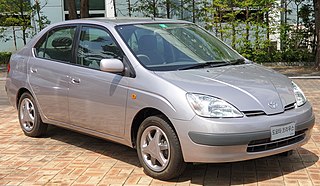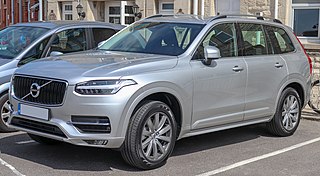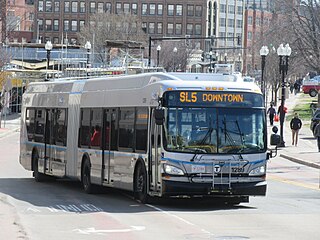Related Research Articles

A hybrid vehicle is one that uses two or more distinct types of power, such as submarines that use diesel when surfaced and batteries when submerged. Other means to store energy include pressurized fluid in hydraulic hybrids.

An electric vehicle (EV) is a vehicle that uses one or more electric motors for propulsion. It can be powered by a collector system, with electricity from extravehicular sources, or it can be powered autonomously by a battery. EVs include but are not limited to road and rail vehicles, and broadly can also include electric boat and underwater vessels, electric aircraft and electric spacecraft.

Regenerative braking is an energy recovery mechanism that slows down a moving vehicle or object by converting its kinetic energy into a form that can be either used immediately or stored until needed. In this mechanism, the electric traction motor uses the vehicle's momentum to recover energy that would otherwise be lost to the brake discs as heat. This method contrasts with conventional braking systems. In those systems, the excess kinetic energy is converted to unwanted and wasted heat due to friction in the brakes, or with rheostatic brakes, where the energy is recovered by using electric motors as generators but is immediately dissipated as heat in resistors. In addition to improving the overall efficiency of the vehicle, regeneration can significantly extend the life of the braking system as the mechanical parts will not wear out quickly.

A diesel–electric transmission, or diesel–electric powertrain, is a transmission system for vehicles powered by diesel engines in road, rail, and marine transport. Diesel–electric transmission is based on petrol–electric transmission, a transmission system used for petrol engines.

The Volvo C30 is a three-door, front-engine, front-wheel-drive premium compact hatchback, manufactured and marketed by Volvo Cars from 2006 to 2013, in a single generation. Powered by inline-four and straight-five engines, the C30 is a variant of the Volvo S40/V50/C70 range, sharing the same Ford C1/Volvo P1 platform. Volvo marketed the C30 as a premium hatchback / sports coupe.

The Volvo XC90 is a mid-size luxury SUV manufactured and marketed by Volvo Cars since 2002 and now in its second generation.

The Ford C-Max is a car produced by the Ford Motor Company from 2003 to 2019. It has a five-door compact multi-purpose vehicle (MPV) design. The Ford Grand C-Max has a longer wheelbase.
Hybrid Synergy Drive (HSD), also known as Toyota Hybrid System II, is the brand name of Toyota Motor Corporation for the hybrid car drive train technology used in vehicles with the Toyota and Lexus marques. First introduced on the Prius, the technology is an option on several other Toyota and Lexus vehicles and has been adapted for the electric drive system of the hydrogen-powered Mirai, and for a plug-in hybrid version of the Prius. Previously, Toyota also licensed its HSD technology to Nissan for use in its Nissan Altima Hybrid. Its parts supplier Aisin Seiki Co. offers similar hybrid transmissions to other car companies.

A plug-in hybrid electric vehicle (PHEV) is a hybrid electric vehicle whose battery pack can be recharged by plugging a charging cable into an external electric power source, in addition to internally by its on-board internal combustion engine-powered generator. Most PHEVs are passenger cars, but there are also PHEV versions of sports cars, commercial vehicles, vans, utility trucks, buses, trains, motorcycles, mopeds, military vehicles and boats.

The Ford Reflex is a concept car introduced at the 2006 North American International Auto Show that, according to Ford, "proves small cars can be bold and American". It is a technological showcase that includes solar panel-powered headlights, an integrated child seat, a baby cam with a monitor mounted on the dash, inflatable rear safety belts, and an interior quieted by ground rubber taken from Nike athletic shoe outsoles. A production version of the Reflex design has not yet been announced. It features an advanced diesel-electric hybrid engine with new-generation lithium ion batteries that help deliver up to 65 miles per US gallon of diesel fuel, and can accelerate the vehicle from 0 to 60 mph (97 km/h) in 7 seconds.
Mild hybrids (MHEV) are generally cars with an internal combustion engine (ICE) equipped with a negligibly bigger electric combined motor and generator in a parallel hybrid configuration allowing the engine to be turned off whenever the car is coasting, braking, or stopped, and then quickly restarted once power is again required. Mild hybrids may employ regenerative braking and some level of power assist to the internal combustion engine, but mild hybrids do not have an electric-only mode of propulsion.

The Volvo ECC was an executive luxury concept car built by Volvo in 1992. It was a design exercise in using recycled material and hybrid technology. It was powered by a hybrid electric and gas turbine engine. Many of its lines and general styling were used as inspiration for the first generation Volvo S80. The ECC set a new design language for future Volvo models from the S80 onwards, the most obvious styling feature being the stepped waistline, which was inspired by the similar feature on the 200 Series, whilst retaining some of the angular elements from the 700/900 ranges.
Hybrid vehicle drivetrains transmit power to the driving wheels for hybrid vehicles. A hybrid vehicle has multiple forms of motive power.

A hybrid electric vehicle (HEV) is a type of hybrid vehicle that combines a conventional internal combustion engine (ICE) system with an electric propulsion system. The presence of the electric powertrain is intended to achieve either better fuel economy than a conventional vehicle or better performance. There is a variety of HEV types and the degree to which each function as an electric vehicle (EV) also varies. The most common form of HEV is the hybrid electric car, although hybrid electric trucks, buses, boats and aircraft also exist.

An alternative fuel vehicle is a motor vehicle that runs on alternative fuel rather than traditional petroleum fuels. The term also refers to any technology powering an engine that does not solely involve petroleum. Because of a combination of factors, such as environmental and health concerns including climate change and air pollution, high oil-prices and the potential for peak oil, development of cleaner alternative fuels and advanced power systems for vehicles has become a high priority for many governments and vehicle manufacturers around the world.
PML Flightlink was a Hampshire based firm specialising in the design and manufacture of "pancake" (flat) electric motors. The company operated for over 30 years in a number of markets including defense, aerospace, mobility, motion control, processing and printing. In 2006, they demonstrated an in-wheel electric motor for cars called the Hi-Pa Drive at the British Motor Show in London, using a Mini dubbed the "Mini QED." Two other car manufacturers have also presented concept cars using this technology: Volvo in its Volvo ReCharge, and Ford with a Ford F150 pick-up prototype presented at the 2008 SEMA Show in Las Vegas.

A wheel hub motor, hub motor, or in-wheel motor is a motor that is incorporated into the hub of the wheel. Wheel-hub motors are commonly found on electric bicycles. Electric hub motors were well-received in early electric cars, but have not been commercially successful in modern production cars.

A range extender is a fuel-based auxiliary power unit (APU) that extends the range of a battery electric vehicle by driving an electric generator that charges the vehicle's battery. This arrangement is known as a series hybrid drivetrain. The most commonly used range extenders are internal combustion engines, but fuel-cells or other engine types can be used.

A drivetrain is the group of components that deliver mechanical power from the prime mover to the driven components. In automotive engineering, the drivetrain is the components of a motor vehicle that deliver power to the drive wheels. This excludes the engine or motor that generates the power. In marine applications, the drive shaft will drive a propeller, thruster, or waterjet rather than a drive axle, while the actual engine might be similar to an automotive engine. Other machinery, equipment and vehicles may also use a drivetrain to deliver power from the engine(s) to the driven components.
There are numerous versions of vehicle propulsion systems. Many of those came into fruition due to need for cleaner vehicles. Each of them might have many abbreviations and some might be misleading. This article explains shortly what defines them.
References
- ↑ "British Motor Show: Modified hybrid Mini promises 640bhp performance". Channel 4. July 19, 2006. Archived from the original on 2006-08-19.
- ↑ "Ford's Electric F-150: A Radical Rethink of an American Icon", SEMA eNews, Vol. 11, No. 44, Oct 30, 2008.
- ↑ "The Register: Volvo opens e-car kimono", 31 July 2009.
- ↑ Archived April 10, 2009, at the Wayback Machine